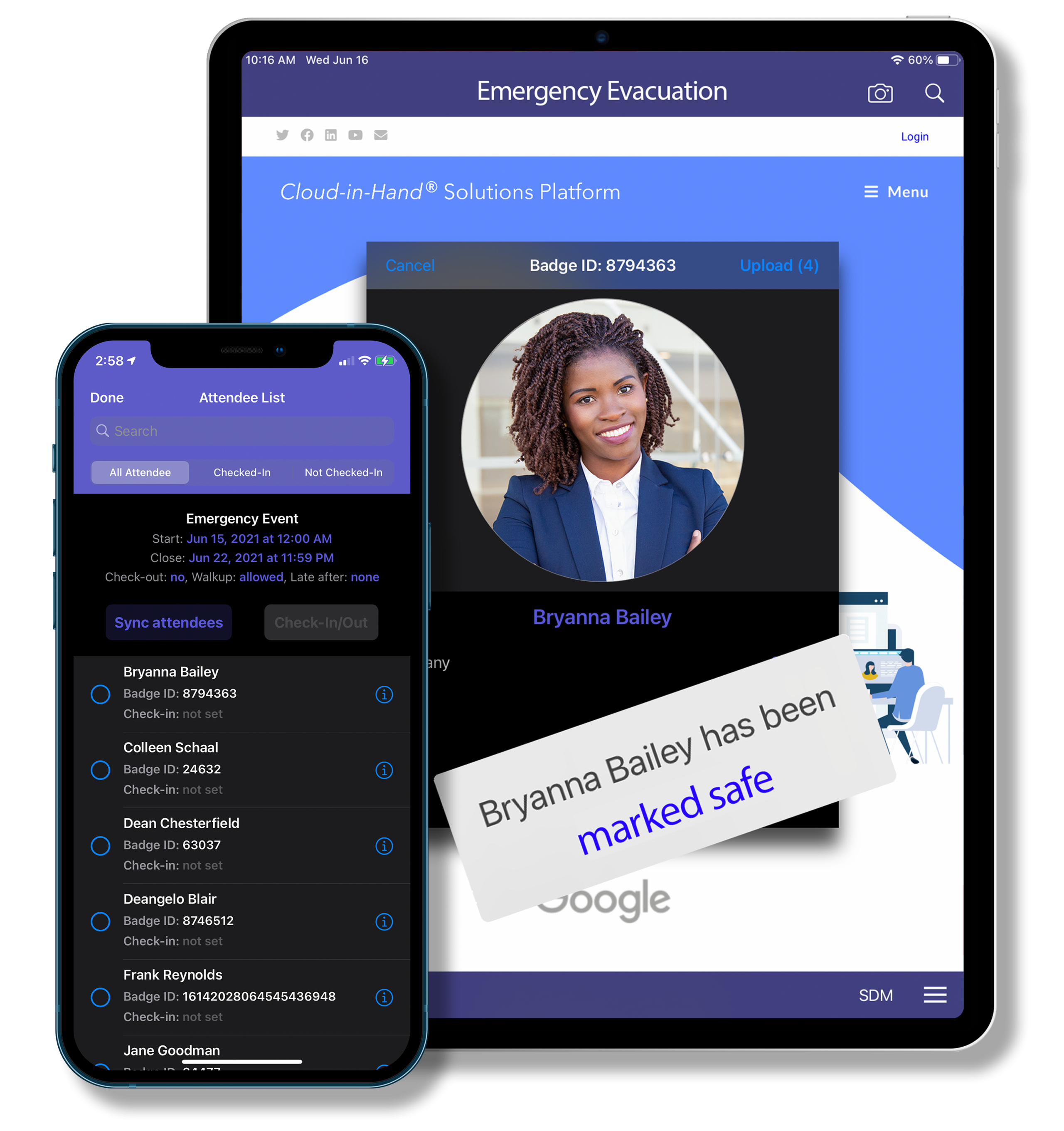
How to Improve your Emergency Evacuation Plan

According to the Federal Emergency Management Agency (FEMA), 25 percent of businesses do not reopen after a disaster. This statistic alone highlights the importance of an emergency evacuation plan. By staying prepared, you not only avoid becoming part of that devastating statistic, but also ensure the safety and well-being of your employees.
As a Safety Coordinator, you have the fire extinguisher in your hands. You’re responsible for ensuring the company doesn’t go down in flames. This means you need to confirm that the company’s emergency evacuation plan is up-to-date with the best tools and practices.
Having an updated emergency plan in place can reduce confusion during a crisis and help keep everyone accounted for. Otherwise, you risk injuries, delays, and potential loss of critical business assets.
Cloud-in-Hand® Solutions Platform provides tools that enhance a business’s emergency evacuation plan through real-time headcount tracking and seamless communication. In this article, we’ll discuss the importance of having an evacuation plan and how you can keep your emergency plan up-to-date.
Stratus-io: Emergency Headcount
The Importance of an Emergency Evacuation Plan
An emergency evacuation plan is essential to any organization as it protects your business and employees during a difficult situation. Think of it as a shield for your operations. It is a structured guide that will help you when a crisis arises and chaos threatens to take over. Without one, you risk falling into the abyss of the unknown, leaving your employees vulnerable, unaccounted for, and your business exposed to costly setbacks.
Common Gaps in Outdated Emergency Plans
Let’s look at some of the common outdated practices that many companies continue to follow. As an organization, your goal is to protect both your people and your assets, so if your current plan includes any of the following, it may be time for an update:
- Only conducting fire drills and ignoring other types of emergencies
- Using a single method of communication (e.g., email only)
- Lacking a plan for individuals with disabilities or special needs
- Outdated or missing evacuation maps and signage
- No established muster (assembly) points
- No backup systems for power, data, or communication
- Ignoring post-emergency procedures
- Relying solely on manual procedures without technology support
Key Elements of an Effective Emergency Evacuation Plan
Establishing a clear emergency evacuation plan helps everyone in the building stay informed during times of chaos. Remember, during an emergency, every second counts, so as a Safety Coordinator, consider your plan has the following:
- It recognizes different emergency events. Many organizations focus solely on tornado procedures, especially in regions where they’re common. However, it’s equally important to prepare for fires, hurricanes, earthquakes, active shooter situations, and other unexpected events.
- It determines how you will communicate. Communication is everything during an emergency. Clearly define how updates will be shared with employees—whether through SMS alerts, overhead announcements, mobile apps, or designated messengers.
- It establishes muster points. Everyone should know exactly where to meet after evacuating. Designated muster points ensure no one is left behind and make headcounts and emergency response coordination easier.
- It lists the different roles and responsibilities. Assigning specific duties, like evacuation leaders or first aid responders, helps everyone stay organized and accountable.
Another very important thing to remember is the post-emergency procedures. Many people overlook this crucial step once the immediate danger has passed. However, debriefing, headcounts, reporting, and follow-up actions are essential for improving future preparedness, and maintaining a safe environment moving forward.
How to Improve your Emergency Evacuation Plan

Stratus-io: A Customer Success Story
Stratus-io helped Procore streamline its 900-person shuttle program with real-time tracking and increased security, eliminating manual headcounts and improving safety. While it was a game-changer for transportation, the benefits extend to emergency planning as well. The same RFID badge scans and live data can be used during evacuations to confirm who’s accounted for and who’s still missing. It’s fast, reliable, and frees you from clipboards and guesswork. If it worked for Procore, it can work for your emergency plan too.
Emergency Evacuation Plan Checklist
To help you get started, or double-check what you already have, we’ve included an emergency plan checklist. It’s designed to guide you through the key components of a strong, modern evacuation strategy. Whether you’re building a plan from scratch or just tightening up a few loose ends, this checklist ensures you’re not overlooking any critical steps.
- Identify potential emergency scenarios (fire, tornado, active shooter, flood, etc.)
- Assign emergency roles and responsibilities
- Design clear evacuation routes and post maps
- Establish primary and secondary muster (assembly) points
- Develop a communication plan (e.g., SMS alerts, PA systems, emergency apps)
- Maintain an up-to-date employee contact list
- Plan for individuals with disabilities or special needs
- Stock emergency supplies and first aid kits
- Train employees on emergency procedures
- Conduct regular evacuation drills
- Keep exits and hallways clear at all times
- Install and maintain emergency signage and lighting
- Create post-evacuation headcount procedures
- Make the emergency plan easily accessible to all staff
- Integrate Stratus-io: Emergency Headcount in your Emergency Plan
Is your Emergency Evacuation Plan Outdated?
Is your emergency evacuation plan outdated? Watch the video below to see how Stratus-io: Emergency Headcount can help your organization enhance emergency preparedness!

Cloud-In-Hand® Solution Team
This blog reflects the expertise of the Cloud-In-Hand® Solution Team with over 100 years of experience in hardware, software, and firmware development. Since founding Solutions Consulting in 1992, now known as Serialio LTD, the Solution Team has designed and developed many innovative solutions. Cloud-In-Hand® Stratus-io Time and Attendance, helps organizations like Apple, Google, Toshiba, LinkedIn, Salesforce, and many more, streamlining their operations.



